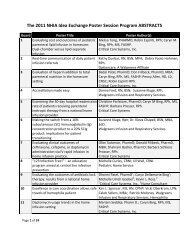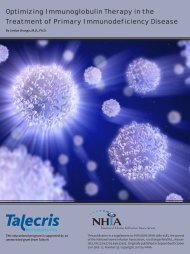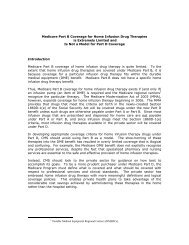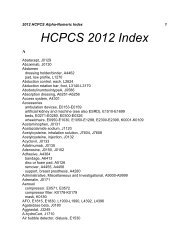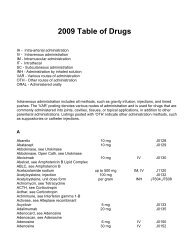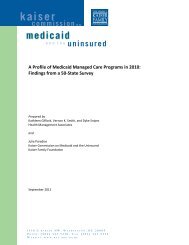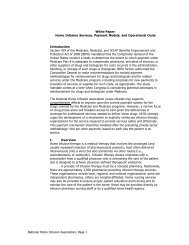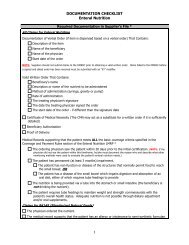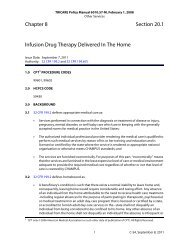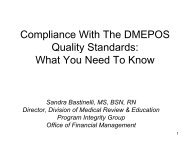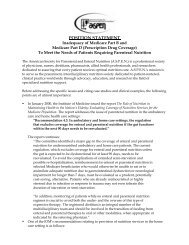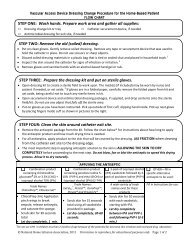Navigating Home Care: Parenteral Nutrition—Part Two
Navigating Home Care: Parenteral Nutrition—Part Two
Navigating Home Care: Parenteral Nutrition—Part Two
You also want an ePaper? Increase the reach of your titles
YUMPU automatically turns print PDFs into web optimized ePapers that Google loves.
NUTRITION ISSUES IN GASTROENTEROLOGY, SERIES #11<br />
Series Editor: Carol Rees Parrish, M.S., R.D., CNSD<br />
<strong>Navigating</strong> <strong>Home</strong> <strong>Care</strong>:<br />
<strong>Parenteral</strong> <strong>Nutrition—Part</strong> <strong>Two</strong><br />
by Gisela Barnadas<br />
<strong>Parenteral</strong> nutrition (PN) is often used for patients who are unable to absorb sufficient<br />
nutrition through the gastrointestinal tract. PN can be safely administered in the<br />
home setting with proper assessment and monitoring of the patient. An interdisciplinary<br />
team approach is used to identify and avoid potential complications, which may<br />
occur. This article provides the physician with specific guidelines for evaluating,<br />
ordering and monitoring PN therapy in the home patient. It also addresses financial<br />
and reimbursement considerations with emphasis on understanding the often confusing,<br />
Medicare guidelines.<br />
CASE 1<br />
JR is a 65-year-old female with vascular disease,<br />
hypertension, diabetes and history of a hysterectomy.<br />
She presents with severe abdominal pain, vomiting and<br />
diarrhea. A small bowel series documents a bowel<br />
obstruction, most likely due to bowel ischemia. Findings<br />
during surgical intervention included: twisted,<br />
gangrenous small bowel with multiple adhesions<br />
resulting in resection of her distal jejunum, ileum and<br />
right colon, leaving an intact duodenum, approximately<br />
100 cm of the jejunum and most of her left colon. She<br />
will most likely require TPN for the rest of her life.<br />
• What needs to be considered to successfully manage<br />
her nutritional needs at home<br />
• How many calories How many grams of protein<br />
• How much volume will she need<br />
• Should I use a standard solution, or does this patient<br />
require something special<br />
• Can the patient and /or caregiver and/or family<br />
manage this therapy at home<br />
Gisela Barnadas, RD, MS, <strong>Home</strong> Nutrition Support<br />
Specialist, MedStar Health Infusion, Inc., Greater<br />
Washington, DC/Baltimore Area.<br />
• What resources are available to help manage this<br />
patient in the home<br />
• What resources are there available for the patient<br />
• Will insurance pay for this<br />
Providing total parenteral nutrition in the home<br />
(HPN) is by no means a new treatment option. The<br />
first record of a patient receiving HPN was a 36-yearold<br />
woman with extensive metastatic ovarian carcinoma<br />
in 1968.(1) While the exact number of people<br />
receiving HPN is not known, Dr Lyn Howard in the<br />
late 1980s and early 1990s in an attempt to establish a<br />
database, estimated approximately 45,000 were on<br />
HPN (2).<br />
Much has changed since the first patient received<br />
HPN thirty-five years ago. With the advent of newer<br />
technologies and greater clinical expertise, HPN can<br />
be safely administered in the home for many conditions.<br />
However, along with improvements in this therapy,<br />
a myriad of challenges to the managing physician<br />
and health care team have also arisen.<br />
The majority of patients end up on HPN after a<br />
hospital admission, others may be a “new start up” at<br />
home (to be addressed later in this article). Regardless,<br />
successful HPN requires evaluating the patient for<br />
PRACTICAL GASTROENTEROLOGY • NOVEMBER 2003 13
<strong>Navigating</strong> <strong>Home</strong> <strong>Care</strong>: <strong>Parenteral</strong> <strong>Nutrition—Part</strong> <strong>Two</strong><br />
NUTRITION ISSUES IN GASTROENTEROLOGY, SERIES #11<br />
Table 1<br />
HPN Checklist: Is Patient A Suitable Candidate<br />
• Risks and benefits of therapy have been discussed with<br />
patient.<br />
• All attempts to use GI tract have failed unless patient is<br />
clearly not appropriate for enteral feedings.<br />
• Modification of diet, use of feeding tube, special formulas,<br />
digestive enzymes, antiemetics, etc. have been<br />
attempted or considered.<br />
• Use of therapy is consistent with level of medical care.<br />
• Patient and/or caregiver assumes role of primary caregiver<br />
and is willing to administer therapy.<br />
• Patient and/or caregivers are capable to perform the<br />
task. Must demonstrate sound judgment and motivation<br />
to learn.<br />
• Patient and/or caregivers accept emotional requirements<br />
to administer therapy at home.<br />
• Patient and /or caregiver meet physical requirement to<br />
provide care (manual dexterity, adequate vision, physical<br />
strength to carry >10 lbs).<br />
• Patient is medically stable (requires labs no more than<br />
1–2× per week, glucose is controlled while on TPN).<br />
• <strong>Home</strong> environment is reasonably clean and has physical<br />
requirements needed to provide therapy (electricity,<br />
water, refrigeration, telephone).<br />
• Financial considerations/insurance coverage and patient<br />
responsibilities have been explored and patient and<br />
caregivers understand (and accept) cost.<br />
Used with permission Barnadas, G: Nutrition in <strong>Home</strong>care: PN<br />
module (4)<br />
HPN, coordinating their care with close follow-up and<br />
monitoring of clinical progress.<br />
Preparing the Patient for Discharge<br />
Is the patient appropriate for home therapy<br />
Identifying appropriate patients for home therapy is<br />
the first step toward successful HPN (3). Planning<br />
should begin early in order to identify potential obstacles,<br />
which may arise. The medical condition should<br />
be relatively stable. Vital signs, glucose, fluid and electrolytes<br />
are normal (or normal for the patient). Treatment<br />
and therapy options have been discussed and<br />
understood. See Table 1 for a suggested checklist to<br />
determine if patient is appropriate for HPN.<br />
Who will administer the therapy<br />
While care of the patient on HPN will be coordinated<br />
among an interdisciplinary health care team, the<br />
patients and/or their designated caregiver will ultimately<br />
be responsible for administering the therapy.<br />
Skilled IV nurses will be utilized initially to administer<br />
the therapy while the patient and/or their caregivers<br />
are taught. Typically it takes two-to three-days before<br />
the patient is expected to reach a point of self-sufficiency<br />
in the administration of the therapy. (Note: the<br />
role of the home care nurse is to educate the patient<br />
and caregivers until they are independent to<br />
administer the therapy. A common misconception<br />
is that the nurse will be there to administer the<br />
therapy and stay with the patient during the entire<br />
Table 2<br />
Nutrition Support Resources Available<br />
• Oley Foundation www.oley.org 800-776-OLEY<br />
– Has a large patient network that allows patients and<br />
caregivers to communicate with others in similar<br />
situations<br />
– Provides website information<br />
– A free newsletter for patients<br />
– A toll free network<br />
– Equipment exchange<br />
– Strong parents support group<br />
– Annual national conference for patients,<br />
families/caregivers<br />
• American Society of <strong>Parenteral</strong> and Enteral Nutrition<br />
(ASPEN) www.nutritioncare.org (800) 727- 4567<br />
– Standards of Practice for <strong>Home</strong> Nutrition Support<br />
(5)<br />
• Canadian <strong>Parenteral</strong>-Enteral Nutrition Association<br />
(CPENA) www.cpena.ca/home.html 613-825-4341<br />
(Ottawa)<br />
(continued on page 16)<br />
14<br />
PRACTICAL GASTROENTEROLOGY • NOVEMBER 2003
<strong>Navigating</strong> <strong>Home</strong> <strong>Care</strong>: <strong>Parenteral</strong> <strong>Nutrition—Part</strong> <strong>Two</strong><br />
NUTRITION ISSUES IN GASTROENTEROLOGY, SERIES #11<br />
(continued from page 14)<br />
Table 3<br />
Medicare Guidelines for TPN<br />
Clinical Situation<br />
Examples of ICD codes<br />
A Severe short bowel syndrome 579.3 Other and unspecified postsurgical nonabsorption<br />
Surgery within past 3 months, leaving ≤5 feet<br />
of small bowel beyond the ligament of the Treitz<br />
B Severe short bowel syndrome 579.3 Other and unspecified postsurgical nonabsorption<br />
(>3 months ago) that results in: evidence of electrolyte<br />
malabsorption AND fluid intake of 2.5–3 L/day results<br />
in enteral losses that exceed 50% of the oral/enteral<br />
intake AND Urine output less that 1 L/day<br />
C Bowel rest for at least 3 months 555.0 Regional enteritis of small intestine<br />
Symptomatic pancreatitis with or without pancreatic 555.1 Regional enteritis of large intestine<br />
pseudocyst OR severe exacerbation of regional enteritis 555.2 Regional enteritis of small with large intestine<br />
OR proximal enterocutaneous fistula where tube feedings 577.0 Acute pancreatitis<br />
distal to the fistula is not possible.<br />
577.1 Chronic pancreatitis<br />
569.81 Fistula of small intestine<br />
998.6 Persistent postoperative fistula, complication of<br />
procedure<br />
D Complete mechanical small bowel obstruction where 560.81 Intestinal or peritoneal adhesions with obstructions<br />
surgery is not an option and where tube feelings distal 560.89 Specified intestinal obstruction, by mural<br />
to the obstruction is not possible<br />
thickening (i.e. Crohn’s)<br />
560.9 Unspecified intestinal obstruction<br />
557.1 Chronic vascular insufficiency of intestine (superior<br />
mesenteric artery (SMA) syndrome) probably goes<br />
with 560.9 unspecified intestinal obstruction<br />
E<br />
Malabsorption and malnutrition<br />
Severe fat malabsorption (fecal fat exceeds 50% or<br />
oral/enteral intake on a diet of at least 50 gm of fat per<br />
day as measured by a standard 72-hour fecal fat test).<br />
AND malnutrition, as evidenced by: 10% weight loss<br />
over 3 months or less AND serum albumin equal to<br />
or less that 3.4 gm/DL<br />
579.9 Unspecified intestinal malabsorption<br />
AND 263.9 Calorie malnutrition<br />
AND 273.8 Hypoalbuminemia<br />
F Motility disturbance and malnutrition 536.3 Gastroparesis<br />
Severe motility disorder of the small intestine and/or 564.9 Unspecified functional disorder of intestine<br />
stomach, which is unresponsive to prokinetic medications<br />
and is demonstrated scintigraphically or radiographically.<br />
AND malnutrition, as evidenced by: 10% weight loss AND 263.9 Calorie malnutrition<br />
over 3 months or less AND serum albumin equal to or AND 273.8 Hypoalbuminemia<br />
less that 3.4 gm/DL<br />
(continued on page 19)<br />
16<br />
PRACTICAL GASTROENTEROLOGY • NOVEMBER 2003
<strong>Navigating</strong> <strong>Home</strong> <strong>Care</strong>: <strong>Parenteral</strong> <strong>Nutrition—Part</strong> <strong>Two</strong><br />
NUTRITION ISSUES IN GASTROENTEROLOGY, SERIES #11<br />
(continued from page 16)<br />
Table 3 (continued)<br />
Medicare Guidelines for TPN<br />
Clinical Situation<br />
Examples of ICD codes<br />
G Malnourished as evidenced by: 10% weight loss over 263.9 Calorie malnutrition<br />
3 months or less<br />
+ AND serum albumin equal to or less that 3.4 gm/DL AND 273.8 Hypoalbuminemia<br />
H AND Has a disease and clinical condition documented AND Any non severe manifestation of above such as:<br />
as being present and it has not responded to altering<br />
• Mild to moderate exacerbation of Crohns<br />
the manner of delivery of appropriate nutrients<br />
• Distal entercutaneous fistula<br />
• Partial bowel obstruction<br />
• Mild to Moderate fat malabsorption<br />
• Mild to Moderate GI dysmotility<br />
Used with permission Barnadas, G: Nutrition in <strong>Home</strong>care: PN module (4)<br />
infusion.) For most patients on HPN, nursing visits<br />
after the first week of therapy are often reduced to<br />
once per week to supervise compliance, provide site<br />
dressing care and obtain lab work. While the patient<br />
may wish to assume all the responsibility for the therapy,<br />
physical and medical limitations sometimes<br />
require a dependable caregiver to assume this responsibility.<br />
A certain amount of visual acuity, physical<br />
strength and manual dexterity is needed to administer<br />
the solution, operate the pump and care for the<br />
catheter. <strong>Care</strong>givers are often very apprehensive when<br />
it comes to administering therapy. While they are anxious<br />
to get the patient back home, they also have fears<br />
they might harm their loved one in the process of providing<br />
care.<br />
Is there a safe home environment<br />
A proper home environment is essential to safely provide<br />
the therapy and avoid infection or other complications.<br />
The home should be stable, safe, relatively<br />
clean and meet certain physical requirements. HPN<br />
therapy requires refrigeration of the solution and maintenance<br />
of a sterile field during catheter care and formula<br />
administration. If the home does not have electricity,<br />
running water and a telephone, alternative plans<br />
may need to be explored. For example, limited telephone<br />
service for medical emergencies can be<br />
arranged through the local telephone company, or<br />
power can be restored under special funds available for<br />
patients receiving life-supporting therapies. Certain<br />
home environments are not safe or appropriate for the<br />
therapy and alternative plans must be investigated.<br />
Social And Emotional Considerations<br />
Food is a very important part of our social environment.<br />
It is a focal point at most gatherings and celebrations.<br />
Patients receiving HPN are often excluded<br />
from partaking in food at social events resulting in<br />
potential distress for the patient and their loved ones.<br />
Family and friends also have difficulty or feel guilty<br />
when they eat around someone who is not able to. Support<br />
groups and organizations such as the Oley foundation<br />
can help patients and families cope with such<br />
matters (see Table 2 for resources available).<br />
Will Insurance Pay For This Therapy At <strong>Home</strong><br />
Private Insurance and Medicaid<br />
Private insurance and Medicaid criteria vary based on<br />
individual policies and state guidelines, but will usually<br />
cover HPN if it is medically indicated and all their<br />
required pre-authorizations and forms are completed.<br />
However, sometimes third party payers cover only 80%<br />
to 90%, leaving a significant share for the patient. Con-<br />
PRACTICAL GASTROENTEROLOGY • NOVEMBER 2003 19
<strong>Navigating</strong> <strong>Home</strong> <strong>Care</strong>: <strong>Parenteral</strong> <strong>Nutrition—Part</strong> <strong>Two</strong><br />
NUTRITION ISSUES IN GASTROENTEROLOGY, SERIES #11<br />
Table 4<br />
Supporting Documentation (required) for<br />
Medicare to Cover TPN at <strong>Home</strong><br />
• Completed CMN<br />
• Objective evidence (“proof”) of medical condition as<br />
documented in operative report, discharge summary, x-<br />
ray report, GI motility studies, consultant notes, clinical<br />
progress notes and/or detailed physician’s letter.<br />
• Attempts to feed orally or enterally, modification of nutrients,<br />
use of medications to allow for oral/enteral feedings.<br />
• Motility studies (Criteria F) (small bowel follow through,<br />
Sitz marker study)<br />
– Failed motility is defined as isotope failing to reach<br />
right colon by 6 hours after administration.<br />
– Must be performed when the patient is not actually ill<br />
and is not on any medication which would decrease<br />
bowel motility.<br />
• Documentation of malnutrition. (Required for Criteria<br />
E–H)<br />
– 10% weight loss over 3 months or less.<br />
– Documentation of weight loss: current wt and wt 1–3<br />
months prior to TPN.<br />
– Nutritional assessment (MD, RD or other qualified personnel)<br />
within 1 week prior to initiation of TPN.<br />
• Must include documentation of intake (oral and tube)<br />
during prior month.<br />
– Serum albumin equal to or less that 3.4 gm/dL.<br />
• Albumin must be within 1 week of TPN initiation.<br />
• Tube feeding trial (see Table 5 for definition and when<br />
required)<br />
• Intake and output (Criteria B and C)<br />
• Laboratory data<br />
– To document malnutrition (Criteria E-H).<br />
– To document electrolyte disorder (Criteria B).<br />
– Fecal fat test document malabsorption, (Criteria D).<br />
– Fat malabsorption is defined as fecal fat > 50% of<br />
oral/enteral intake on a diet of 50g of fat/day as measured<br />
by standard 72 hour fecal fat test.<br />
– Malabsorption tests (Criteria B and H).<br />
• List of medications used to:<br />
– Control diarrhea (pancreatic enzymes, bile salts, and<br />
meds that slow gut transit time) (Criteria B, E–H).<br />
– Bacterial overgrowth (broad spectrum antibiotics) (Criteria<br />
B, E–H).<br />
– Assist motility (Criteria F).<br />
• Unresponsiveness to prokinetic drugs is defined as<br />
presence of daily symptoms of nausea/vomiting while<br />
on maximal doses.<br />
Used with permission Barnadas, G: Nutrition in <strong>Home</strong>care:<br />
PN module (4)<br />
sidering TPN can cost >$200/day the patient may still<br />
have a $20–$40 per day co-pay (>$7000–$15,000/year).<br />
Medicare<br />
Medicare part B will cover 80% of their approved cost<br />
for parenteral nutrition in the home under very specific<br />
criteria (6). Tables 3 and 4 outline clinical situations and<br />
required documentation needed for Medicare coverage<br />
of HPN. In addition to meeting the test of permanence<br />
(remember Medicare defines permanence as >90 days),<br />
there must be clear evidence that the GI tract is nonfunctioning<br />
and that all possible attempts have been<br />
made to utilize it. A completed certificate of medical<br />
necessity (CMN), extensive justification and documentation<br />
are required. Objective evidence must convey the<br />
reason the GI tract is non-functioning and outline specific<br />
attempts which were made to improve the situation.<br />
Medicare requires an attempt at tube feeding whenever<br />
the condition allows (see Table 5 for more specific<br />
examples). Medicare will not cover intra-dialytic parenteral<br />
nutrition (IDPN) unless the patient meets above<br />
guidelines as well. Figure 1 provides an algorithm which<br />
will help to determine if your patient meets Medicare criteria<br />
for coverage of parenteral nutrition.<br />
(continued on page 22)<br />
20<br />
PRACTICAL GASTROENTEROLOGY • NOVEMBER 2003
<strong>Navigating</strong> <strong>Home</strong> <strong>Care</strong>: <strong>Parenteral</strong> <strong>Nutrition—Part</strong> <strong>Two</strong><br />
NUTRITION ISSUES IN GASTROENTEROLOGY, SERIES #11<br />
(continued from page 20)<br />
WILL MEDICARE COVER TPN<br />
Is the GI nonfunction “permanent” (>90 days)<br />
NO<br />
Complete<br />
intestinal<br />
obstruction<br />
and surgery is<br />
not an option<br />
YES<br />
Why is the GI tract not funcitoning<br />
Short Gut, Need for Bowel Rest, Malabsorption,<br />
GI Dysmotility, Severe Malnutrition<br />
Expected to<br />
resume gut<br />
function in
<strong>Navigating</strong> <strong>Home</strong> <strong>Care</strong>: <strong>Parenteral</strong> <strong>Nutrition—Part</strong> <strong>Two</strong><br />
NUTRITION ISSUES IN GASTROENTEROLOGY, SERIES #11<br />
according to the medical condition, overall nutritional<br />
status, level of activity and stress. Standard multivitamin<br />
and trace mineral preparations available are<br />
designed to meet usual daily requirements of most<br />
patients. Extraordinary mineral loss such as zinc loss<br />
in the setting of diarrhea needs further consideration.<br />
Total nutrient admixtures (3-in-1 solutions) are<br />
primarily used at home because they are easier for the<br />
patient to administer and require less manipulation of<br />
the line. The total volume and electrolyte composition<br />
of the HPN fluid ordered should anticipate<br />
extraordinary losses from vomiting, diarrhea, fistula<br />
and ostomy in order to provide appropriate<br />
replacement. The electrolyte composition of the HPN<br />
formula should mimic the fluid being lost. For example,<br />
gastric secretions and small bowel ostomy output<br />
are high in sodium and chloride, whereas colostomy<br />
Table 5<br />
Criteria for Tube Feeding Trial<br />
• Effort must be made to place a tube.<br />
• In situations of fistula or obstruction, feed distal if<br />
possible.<br />
• For gastroparesis must be post-pylorus (preferably in<br />
jejunum).<br />
• Placement in jejunum must be objectively verified (xray<br />
or fluoroscopy).<br />
• Trial with enteral nutrition must be made with attention<br />
to dilution, rate and use of alternative formula.<br />
Examples of failed trials:<br />
• Patient continues to vomit after placement of tube<br />
post-pyloric.<br />
• Tube fails to progress into jejunum after 5–6 hours.<br />
Feeding was attempted using a slow drip but patient<br />
vomited as rate was increased.<br />
• Feeding tube is in jejunum but after 1–2 days of feeding<br />
patient has abdominal distention and vomiting.<br />
• Over the course of a few weeks attempts to gradually<br />
advance formula results in diarrhea or other signs of<br />
intolerance and patient is unable to reach nutritional<br />
goal.<br />
Used with permission Barnadas, G: Nutrition in <strong>Home</strong>care:<br />
PN module (4)<br />
Table 6<br />
Stepwise Approach to Insulin Dose/Glucose Control<br />
of the Diabetic Patient (10)<br />
1. Remove all insulin from PN.<br />
2. Give insulin separate from PN for the first 24 hours in<br />
response to frequently measured glucose levels.<br />
3. Calculate the amount of insulin used in 24 hours.<br />
4. <strong>Two</strong>-thirds of the insulin given in the previous 24<br />
hours is added to the next days PN prescription.<br />
5. Patient continues to monitor glucose and receives<br />
insulin coverage as needed.<br />
6. Further adjustments of insulin additions are made<br />
according to measured serum glucose levels.<br />
output and diarrhea fluid loss would result in a greater<br />
loss of bicarbonate and potassium.<br />
Patients with fluctuating or high fluid loss may be<br />
better managed with separate IV fluids or hydration<br />
fluids. For example, TPN is ordered with the volume<br />
appropriate to meet the usual fluid needs. Additional<br />
“shelf stable” hydration such as 0.45NS or Lactated<br />
Ringers, can be used to meet transient losses or when<br />
output exceeds a predetermined amount. These solutions<br />
can be infused at a much faster rate than TPN.<br />
Example:<br />
Patient gets 2400 mL TPN at night over 12 hrs<br />
and is told to infuse an additional liter of 0.45NS<br />
at 250–350 cc/hr over 2–4 hrs during the day.<br />
The patient is taught the signs of dehydration and<br />
is instructed to infuse an additional liter over 4<br />
hrs whenever their GI loss is increased above<br />
normal, or if their urine output drops or if they<br />
start to feel dehydrated. The home care clinical<br />
team monitors usage and alerts the physician<br />
when significant deviations occur.<br />
Hyperglycemia is the most common complication<br />
and is directly related to the amount of dextrose content<br />
of the solution. Patients (without diabetes) who<br />
received TPN with a dextrose rate >5mg/kg/min have<br />
been documented to have a 49% chance of developing<br />
hyperglycemia. In contrast, those who received an<br />
infusion at
<strong>Navigating</strong> <strong>Home</strong> <strong>Care</strong>: <strong>Parenteral</strong> <strong>Nutrition—Part</strong> <strong>Two</strong><br />
NUTRITION ISSUES IN GASTROENTEROLOGY, SERIES #11<br />
(continued from page 23)<br />
Table 7<br />
Typical Lab Work Schedule<br />
Lab parameter Baseline Weekly Other<br />
Comprehensive metabolic ✔ ✔ Reduce to monthly or quarterly when appropriate<br />
panel (CMP)<br />
Electrolytes, BUN, Cr,<br />
Albumin, LFT’s, Ca, PO 4 , Mg<br />
CBC with differential ✔ ✔ Reduce to monthly or quarterly when appropriate<br />
PT/PTT/INR ✔ — ✔ monthly or as indicated<br />
Triglyceride level ✔ — ✔ monthly or as indicated<br />
Iron studies, B 12 , Folate — — ✔ q 6 months or if deficiency suspected<br />
Vitamin/minerals ✔ if deficiency — Consider yearly assessment of Vitamin A, D, E<br />
suspected<br />
Se, Zn, Mn, Cu<br />
Essential fatty acids — — ✔ if deficiency suspected<br />
Bone density — — Consider yearly assessment<br />
Used with permission Barnadas, G: Nutrition in <strong>Home</strong>care: PN module (4)<br />
risk of hyperglycemia (9). See Table 6 for a suggested<br />
approach to insulin dosing in the diabetic patient.<br />
CASE 2<br />
A 32-year-old male was admitted with intractable<br />
vomiting related to chemotherapy; he was unable to<br />
eat or drink and was experiencing copious amounts of<br />
emesis (> 3 liters/day). Unfortunately the patient was<br />
discharged home on only 2-liters of PN with standard<br />
electrolytes and additives. The patient became increasingly<br />
confused and had reduced urine output. He was<br />
hospitalized with dehydration and hyponatremia.<br />
Could this hospitalization have been avoided<br />
YES, with an interdisciplinary team approach!<br />
• Use of a standard formula containing 45 mEq NaCl<br />
and 2 L of fluid per day was not appropriate for this<br />
patient. Standard additives will not compensate for<br />
this patient’s extraordinary GI loss.<br />
• Nutrition assessment at the initiation of the therapy<br />
should have anticipated the need for higher volume<br />
and sodium concentration to mimic the electrolyte<br />
content of the secretions lost.<br />
• <strong>Home</strong> care nutrition support specialists (if the<br />
provider employs them) should have evaluated the<br />
therapy based on the clinical condition at the time of<br />
initiation of service and discussed concerns with the<br />
ordering physician.<br />
• Health care team’s ongoing evaluation of antiemetic<br />
therapy.<br />
Schedule of Infusion<br />
In the hospital setting most infusions of TPN are over<br />
24 hours. For home, most (but not all) patients typically<br />
prefer to cycle the infusion at night. Ten to fourteen<br />
hours (although some infuse over 8 hours) is ideal<br />
for most home care patients. This means that the average<br />
flow rates for many home patients run ~150–350<br />
mL/hour an amount not commonly seen in the typical<br />
hospital patient.<br />
For some, infusing large volumes at night, especially<br />
those who are bed bound, may prove difficult.<br />
Others, with excess losses, feel better when fluid and<br />
PRACTICAL GASTROENTEROLOGY • NOVEMBER 2003 27
<strong>Navigating</strong> <strong>Home</strong> <strong>Care</strong>: <strong>Parenteral</strong> <strong>Nutrition—Part</strong> <strong>Two</strong><br />
NUTRITION ISSUES IN GASTROENTEROLOGY, SERIES #11<br />
Table 8<br />
Starting TPN at home, sample progression (Pt weight = 66 kg)<br />
Nutrient Goal/kg Total Goal Day 1 Day 4 Day 7<br />
Fluids (cc) ~35cc 2300 1500 2300 2300<br />
Hours 12 12 12 12<br />
Dextrose (g) ~4.5g 300 150 (10%) 250 (11%) 300 (13%)<br />
Protein (g) ~1.2g 80 80 80 80<br />
Lipids (g) ~1g 65 65 65 65<br />
Calories ~30–35 kcal 2000–3000 1480 1820 2000<br />
Monitoring<br />
Total Goal: Baseline labs done prior to start of therapy and abnormalities addressed<br />
Day 1: Pt checks glucose fingerstick. Day 3 Check: BMP+Mg+PO 4 ; If OK adjust/advance formula → →<br />
Day 4: Day 6 Check: CMP+Mg+PO 4 CBS; If OK adjust/advance formula → →<br />
Day 7: Monitor tolerance<br />
Used with permission Barnadas, G: Nutrition in <strong>Home</strong>care: PN module (4)<br />
nutrition are dispersed throughout the day and night.<br />
Ideally, transition patients to the planned home regimen<br />
as early as possible to “work out the kinks” a few<br />
days prior to discharge.<br />
MONITORING<br />
Lab Work<br />
At home, patients are more stable than in the hospital.<br />
Labs are initially checked 1–2 times during the first<br />
week, then weekly thereafter. “STAT labs” are not possible<br />
at home. The turnaround time for lab work is usually<br />
24 hours. Once lab results are received, they are<br />
reviewed by the home care staff and ordering physician.<br />
The TPN formula is adjusted if need be, and the following<br />
weeks shipment is compounded and sent. After a stable<br />
pattern is established, the frequency of lab work can<br />
be reduced to every two weeks, then every month. Longterm<br />
patients, who are stable may need labs checked<br />
only once or twice per year. The pharmacist or nutrition<br />
specialist at the home care company should be trending<br />
the labs and anticipating when a change in frequency or<br />
other parameters are needed. A sample schedule of lab<br />
work for HPN patients can be found in Table 7.<br />
Long-term patients may need other tests such as<br />
vitamin and mineral determinations and bone density<br />
studies. Special tests such as prealbumin with its short<br />
half life of 2–3 days are often used in acute settings but<br />
are of little benefit in the long term patient. These tests<br />
are expensive and because of the longer turnaround<br />
time, the results may cross your desk a few days after<br />
the TPN has been compounded, (and the value is now<br />
questionable).<br />
Nutritional Assessment and Monitoring<br />
Should be Ongoing<br />
Systematic evaluation should be conducted to determine<br />
if the nutrition plan continues to be consistent with<br />
needs. Records of intake and output, body weight and<br />
overall status are desirable. Assessment should consider<br />
more subjective parameters such as appearance, strength<br />
and endurance, skin integrity, improved mental and<br />
physical status or an overall feeling of well being which<br />
offer insight to nutritional well being. Through monitoring,<br />
the risks of complications can be minimized and the<br />
nutritional status can be maintained or improved.<br />
CAN TPN BE STARTED AT HOME<br />
Most patients who receive PN in the home started out<br />
in the hospital setting and transitioned to the home.<br />
(continued on page 30)<br />
28<br />
PRACTICAL GASTROENTEROLOGY • NOVEMBER 2003
<strong>Navigating</strong> <strong>Home</strong> <strong>Care</strong>: <strong>Parenteral</strong> <strong>Nutrition—Part</strong> <strong>Two</strong><br />
NUTRITION ISSUES IN GASTROENTEROLOGY, SERIES #11<br />
(continued from page 28)<br />
However, with some patient populations who are more<br />
stable, therapy has been successfully initiated in the<br />
outpatient setting without the need for hospitalization<br />
(exclusions might be: patients with diabetes mellitus,<br />
renal failure, cardiac problems, high refeeding risk,<br />
etc). The patient will require the same initial scrutiny<br />
for appropriateness of therapy and will need a suitable<br />
central access. The TPN solution is typically begun at<br />
a lower concentration of dextrose and advanced over<br />
the first week. Protein, lipids and electrolytes do not<br />
need the same gradual increase and can usually be<br />
started at the goal amount. Labs are drawn and evaluated<br />
before therapy is started and at intervals during<br />
the progression. Close attention is placed on serum<br />
levels of K, Mg and PO 4 as they may drop due to<br />
“refeeding syndrome” as the glucose is advanced. The<br />
patient is instructed to check glucose using a glucometer<br />
or glucose reagent strips at least once during infusion<br />
and 1 hour after PN is disconnected. See Table 8<br />
for a sample progression of HPN for a home start up.<br />
In this example, the patient has advanced to goal<br />
and is receiving full nutrition support by the end of the<br />
first week.<br />
your patients in the management of HPN and ensure<br />
the patient achieves the maximum benefit from their<br />
therapy. ■<br />
References<br />
1. Dudrick S. Proceedings of <strong>Home</strong> <strong>Parenteral</strong> and Enteral Workshop.<br />
JPEN, 2002; 26: S2-S3.<br />
2. North American home enteral and parenteral patient registry.<br />
Annual Reports 1985–1990. The Oley Foundation, Albany, NY,<br />
1987-1992.<br />
3. Barnadas G. Preparing for parenteral nutrition therapy at home.<br />
Am J Health Syst Pharm, 1999;56:270-273.<br />
4. Barnadas G. Nutrition in <strong>Home</strong>care: PN module,2003.<br />
5. ASPEN Board of Directors. Standards of Practice: Standards for<br />
<strong>Home</strong> Nutrition Support. NCP, 1999; 14:151-162.<br />
6. Region B DMERC Suppliers Manual, Medical Policy Revision 6<br />
March 1996 www.adminastar.com/anthem/affiliates/adminastar/dmerc/index.html<br />
(accessed: 8/12/2003)<br />
7. Solomon SM, Kirby DF. The refeeding syndrome: A review.<br />
JPEN, 1990; 14:90-97.<br />
8. Brooks MJ, Melnik G. The refeeding syndrome: An approach to<br />
understanding its complications and preventing its occurrence.<br />
Pharmacotherapy, 1995; 15:713-726.<br />
9. Rosmarin DK, Warlaw GM, Mirtillo J. Hyperglycemia associated<br />
with high continuous rates of total parenteral nutrition dextrose.<br />
NCP, 1996; 11:151-156.<br />
10. Ireton-Jones C, DeLegge M, Epperson L, Alexander J: Management<br />
of the <strong>Home</strong> <strong>Parenteral</strong> Nutrition Patient. NCP,<br />
2003;18:310-317.<br />
CONCLUSION<br />
HPN is a complex medical therapy, but one that can be<br />
safely and effectively achieved at home. Early identification<br />
of the potential home candidate and good<br />
communication between healthcare providers is<br />
important. Choosing a home care company that provides<br />
ongoing nutrition monitoring will assist you and<br />
PG<br />
2003 27<br />
27TH<br />
YEAR<br />
Practical Gastroenterology invites its readers to share their<br />
PEARLS OF GASTROENTEROLOGY<br />
Submissions should be brief (about 200 words maximum). Those accepted for publication<br />
may be edited for space and style. An honorarium of $25 will be paid upon publication.<br />
Mail your “Pearls of Gastroenterology” to Practical Gastroenterology<br />
99B Main Street, Westhampton Beach, NY 11978 or fax them to us at (631) 288-4435.<br />
Please include your name, address, affiliations, and telephone and fax numbers.<br />
30<br />
PRACTICAL GASTROENTEROLOGY • NOVEMBER 2003



